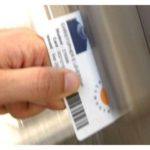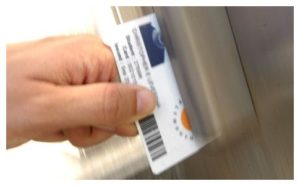
Officials at Northern Arizona University are reminding students that faculty members have the choice to use new electronic scanners that track attendance at the campus’s largest lecture halls, but some students continue their vocal opposition to the technology as the fall semester gets underway.
The Flagstaff, Ariz., university will use “proximity card readers” in freshmen and sophomore classrooms that hold more than 50 students, where calling attendance would eat into valuable class time for instructors.
The scanners would require students to swipe their campus identification cards and create an electronic record that they attended class that day.
Some student protest has remained vocal as the new school year begins. A Facebook group called “NAU Against Proximity Cards” has attracted more than 1,600 members, and campus political groups have excoriated university decision makers for using more than $80,000 in federal stimulus money to create the attendance-tracking program.
Thomas Bauer, a spokesman for NAU, said “some of the negative feedback is based on misinformation” warning students that the attendance scanners will monitor where they are on campus at all time. “The readers are not tracking devices. They cannot and will not be used to track students. They are simply a tool to measure attendance.”
Bauer emphasized that the university doesn’t have an attendance policy for faculty members, and instructors will not be required to use the data collected by the electronic scanners.
“The professors who are asking to be the first to test the system agree with the philosophy behind the readers,” he said. “They also see it as a time-saver for them. Instead of calling roll for 100 students, they can let the reader do it for them, if they want to include attendance in their grading policy.”
Bauer said he was aware of the Facebook page protesting the proximity card members, but he wasn’t sure “if that’s too important or not,” adding that NAU hasn’t received a single parent complaint about the attendance-tracking program.
Student ID cards are already used at the health center, bookstore, dining halls, dormitories, and recreation center on the 23,000-student campus.
Despite the already-widespread use of student ID cards across the NAU campus, some student activists have criticized university officials for using the scanners at lecture halls this fall.
Travis Owen, president of the NAU Conservatives, wrote in a May 13 blog post that recording attendance electronically stripped “any and all liberty out of collegiate educational practices.”
“It is an extremely uncomfortable feeling, the university having data on where I am, and how often I am there,” Owen wrote. “Due to the fact that nearly all students are adults and voters, they are guaranteed certain rights to privacy. This privacy includes doing what one wishes within the law without being held accountable. This monitoring is Orwellian. … It is rules and mandates like this that lead to worse things.”
Rachel Brackett, an NAU student and creator of the Facebook page protesting the proximity cards, wrote on Facebook that the program “allows the school to keep track of our whereabouts in a ‘big brother’ way.”
“We are already paying thousands of dollars to go to school, and I do believe that we are all adults that can make our own decisions,” Brackett wrote. “Are we … children that need to be told what to do?”
NAU officials say the electronic attendance tracking will encourage better attendance for first- and second-year college students—a key component to academic success, according to research and surveys.
A 1990 study of 78 students three business classes at Broome Community College in Binghamton, N.Y., showed that students with “excellent” or “good” attendance—meaning they missed fewer than six classes during the semester—all received a final grade of A, B, or C. Of the 28 students with poor attendance records—defined as more than six absences—11 received final grades of D or F.
Mississippi State University released a survey in 2006 showing that students with consistently poor class attendance had a grade-point average one full point lower than peers who regularly attended class.
Officials at MSU’s Social Science Research Center deemed attendance the best predictor of freshmen’s academic success.
“The better students perform, especially in their early years, the more likely they are to move toward a bachelor’s degree,” said Bauer, the NAU spokesman. “The proximity card readers are a small part of that. If they encourage students to attend class more often, so much the better.”
The University of Kansas’s efforts to boost student retention include working with a data-mining company that can pinpoint at-risk students with consistently low grades and spotty attendance records.
“We’re not going to become Big Brother and look at every move by the undergraduates,” said Christopher Haufler, a Kansas professor who chaired the university’s student retention task force last year. “That, to me, is beyond where we ought to be. … But at the same time, we have a chance to monitor the progress of our students, and if a student hasn’t been going to class, then somebody should do something about it.”
- Research: Social media has negative impact on academic performance - April 2, 2020
- Number 1: Social media has negative impact on academic performance - December 31, 2014
- 6 reasons campus networks must change - September 30, 2014

